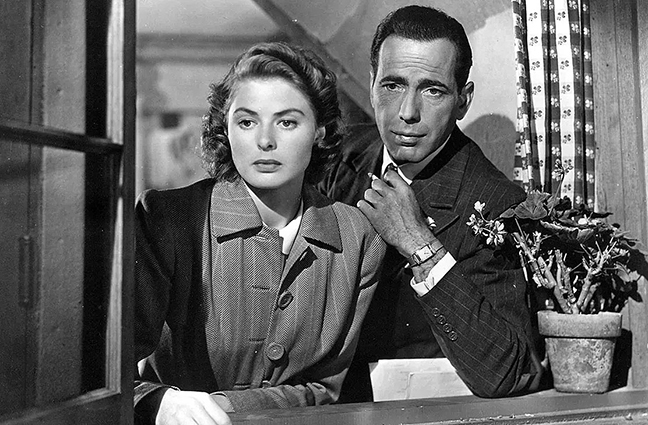Welcome!

Ingrid Bergman and Humphrey Bogart in ‘Casablanca.’
Mr. Movie: Black & white
Colorization is the bastardization of black and white films into dreadful colors. It has been around for a while.
Ted Turner famously tried to colorize Citizen Kane, but he encountered such a firestorm of outraged opposition that he dropped the idea. He, and others, just won’t let it go. And the process produces a dim, washed out look. Good grief!
Lots of movie fans I know tell me they just won’t watch any movie in black and white. BIG MISTAKE! Director Alexander Payne (Sideways, About Schmidt) decided to film Nebraska (2013) in black and white. Excellent choice! Bruce Dern is an aged alcoholic bordering on dementia who receives one of those “you’ve already won one million dollars” things and believes it. He is determined to venture from Montana to Nebraska to claim his prize. He can’t be convinced it’s a scam. Will Forte, really good as his son, decides to humor him and make it a road trip. And June Squibb is superb as Dern’s long-suffering wife. The film got five Oscar nominations, including Best Picture. The dreary, barren Midwestern landscape, the dingy small towns and the dysfunctional family members are perfect in black and white.
And remember while we’re on this topic that a black and white movie, The Artist, won the Best Picture Oscar for 2011 (it’s also silent!).
Orson Welles perhaps understood how to use the subtle shadings of black and white better than anyone else. His landmark film Citizen Kane (1941) is exhibit A. But an even better use of the medium, though a lesser film, is The Magnificent Ambersons (1942), which is shot almost entirely in the gloomy old Amberson mansion.
In Raging Bull (1980), the brutality and violence of the ring (and the kitchen) are more exquisitely captured in black and white than any color imaginable. The sleazy, smoky nightclubs that become Jake LaMotta's environment seem much more oppressive and atmospheric in black and white.
Casablanca (1942) has dark filmic echoes of the war and the end of a culture, and is one of the most romantic films ever made. I cannot imagine it in color.
My favorite example of black and white cinematography is How Green Was My Valley (1941), about life in a Welsh mining village and a boy who wants out. Use your freeze button on any frame in this movie and you could hang it on your wall.
Some other splendid examples of black and white: Schindler’s List (1993), The Hustler (1961), High Noon (1952), On the Waterfront (1954), The Maltese Falcon (1941), Good Night And Good Luck (2005) and Brief Encounter (1945).
If you happen to be one of the “never black and white” people, I ask only that you give any of the films in this column a look. Then ask yourself if it would have been better in color.
All of the movies in this column are available on DVD. None are really suitable for children under 12, mostly because they wouldn't like them.
